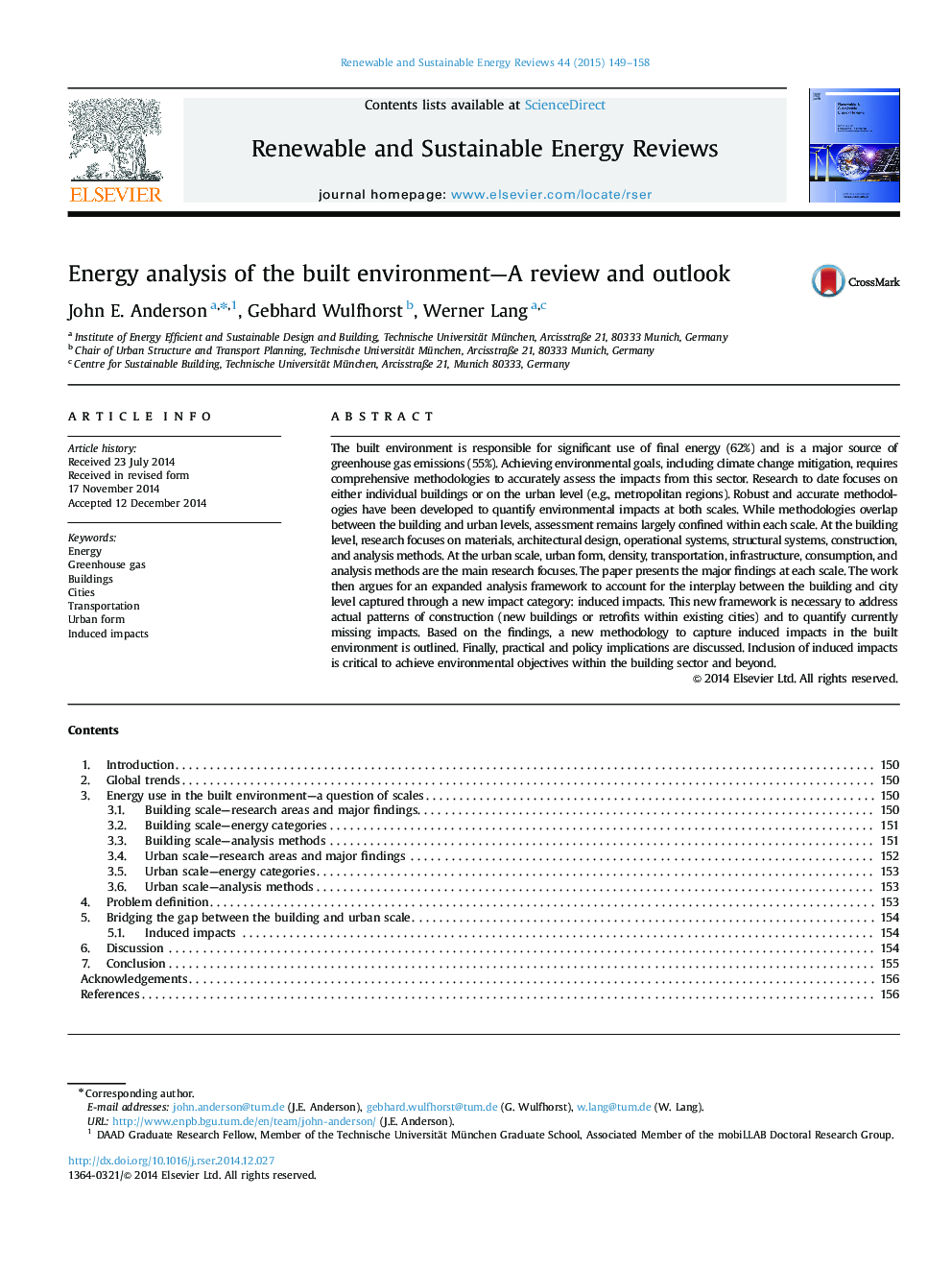| کد مقاله | کد نشریه | سال انتشار | مقاله انگلیسی | نسخه تمام متن |
|---|---|---|---|---|
| 8117126 | 1522341 | 2015 | 10 صفحه PDF | دانلود رایگان |
عنوان انگلیسی مقاله ISI
Energy analysis of the built environment-A review and outlook
ترجمه فارسی عنوان
تجزیه و تحلیل انرژی محیط ساخته شده - بررسی و چشم انداز
دانلود مقاله + سفارش ترجمه
دانلود مقاله ISI انگلیسی
رایگان برای ایرانیان
کلمات کلیدی
انرژی، گاز گلخانه ای، ساختمان ها، شهرها، حمل و نقل، فرم شهری، اثرات منجر شده،
ترجمه چکیده
محیط ساخته شده مسئول استفاده قابل توجه از انرژی نهایی (62٪) است و منبع اصلی انتشار گازهای گلخانه ای (55٪) است. دستیابی به اهداف زیست محیطی، از جمله مقابله با تغییرات اقلیمی، نیازمند روشهای جامع برای ارزیابی دقیق تأثیرات این بخش است. تحقیقات تا به امروز بر روی ساختمانهای فردی یا در سطح شهری (به عنوان مثال، مناطق شهری) تمرکز دارند. روش های دقیق و دقیق برای اندازه گیری اثرات زیست محیطی در هر دو مقیاس توسعه داده شده است. در حالی که متدولوژی ها بین ساختمان ها و سطوح شهری همپوشانی دارند، ارزیابی عمدتا در هر مقیاس محدود می شود. در سطح ساختمان، پژوهش بر روی مواد، طراحی معماری، سیستم های عملیاتی، سیستم های ساختاری، ساخت و ساز و روش های تجزیه و تحلیل متمرکز است. در مقیاس شهری، تمرکز اصلی تحقیق، فرم شهری، تراکم، حمل و نقل، زیرساخت ها، مصرف و روش های تجزیه و تحلیل است. این مقاله، یافته های اصلی در هر مقیاس را ارائه می دهد. سپس این کار برای یک چارچوب تجزیه و تحلیل گسترش یافته برای اثبات تعامل بین ساختمان و سطح شهر که از طریق یک رده تاثیر جدید گرفته شده است، تأثیر می بخشد. این چارچوب جدید برای رسیدگی به الگوهای واقعی ساخت و ساز (ساختمان های جدید و یا ارتقاء در شهرهای موجود) ضروری است و برای اندازه گیری تاثیرات در حال حاضر از دست رفته است. بر اساس یافته ها، یک روش جدید برای ضبط اثرات القا شده در محیط ساخته شده مشخص شده است. در نهایت، مفاهیم عملی و سیاسی مورد بحث قرار می گیرند. دخالت تأثیرات القا شده برای دستیابی به اهداف زیست محیطی در بخش ساختمان و فراتر از آن ضروری است.
موضوعات مرتبط
مهندسی و علوم پایه
مهندسی انرژی
انرژی های تجدید پذیر، توسعه پایدار و محیط زیست
چکیده انگلیسی
The built environment is responsible for significant use of final energy (62%) and is a major source of greenhouse gas emissions (55%). Achieving environmental goals, including climate change mitigation, requires comprehensive methodologies to accurately assess the impacts from this sector. Research to date focuses on either individual buildings or on the urban level (e.g., metropolitan regions). Robust and accurate methodologies have been developed to quantify environmental impacts at both scales. While methodologies overlap between the building and urban levels, assessment remains largely confined within each scale. At the building level, research focuses on materials, architectural design, operational systems, structural systems, construction, and analysis methods. At the urban scale, urban form, density, transportation, infrastructure, consumption, and analysis methods are the main research focuses. The paper presents the major findings at each scale. The work then argues for an expanded analysis framework to account for the interplay between the building and city level captured through a new impact category: induced impacts. This new framework is necessary to address actual patterns of construction (new buildings or retrofits within existing cities) and to quantify currently missing impacts. Based on the findings, a new methodology to capture induced impacts in the built environment is outlined. Finally, practical and policy implications are discussed. Inclusion of induced impacts is critical to achieve environmental objectives within the building sector and beyond.
ناشر
Database: Elsevier - ScienceDirect (ساینس دایرکت)
Journal: Renewable and Sustainable Energy Reviews - Volume 44, April 2015, Pages 149-158
Journal: Renewable and Sustainable Energy Reviews - Volume 44, April 2015, Pages 149-158
نویسندگان
John E. Anderson, Gebhard Wulfhorst, Werner Lang,
